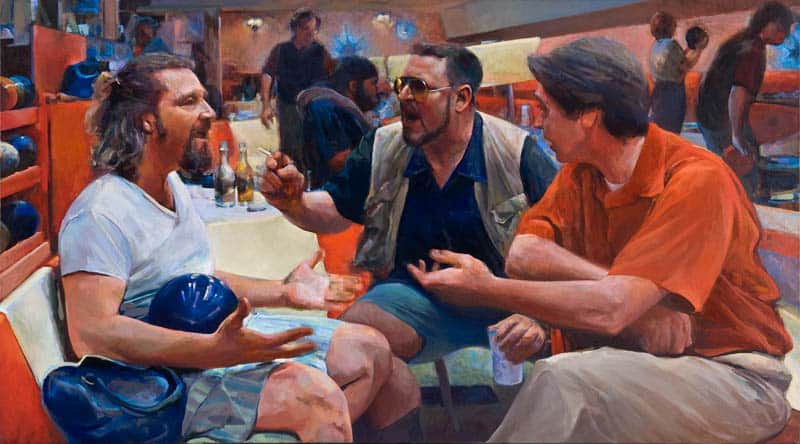
The Coen brothers film ‘The Big Lebowski‘ has inspired countless young folk to don ratty bathrobes and drink white Russians since its release in 1998. The movie has evolved into a cult classic that is adored for both its kitsch quality as well as the depth of cinematic artistry the seeps from every frame.
I found the work of artist Joe Forkan while searching for art inspired by the film, and his work goes beyond the simple fun of movie posters and funny t-shirts. Joe Forkan used ‘The Big Lebowski‘ as the foundation for an epic series of paintings that explore more than just the humor of the Coen’s masterpiece, but also it’s relation to the history of painting as a storyteller’s tool. He lifted The Dude and Walter from their Halloween costumed world and brought out the humanity in the characters and their situations. Joe was inspired to use the ‘The Big Lebowski’ as a way to explore and experiment with the methods of classic painters like Titian and Caravaggio.
This is what artists should be at their core — an explorer, a curious mind delving into new areas, mucking about in new terrain. Fearless.
He is a veteran of comic strips and illustration and is currently a professor of art at California State University Fullerton. I admit that my art history is a bit rusty, but Joe didn’t hold that against me and was kind enough to play along with an interview to discuss the painting process, art school, and what it takes to work on a series of works for five years.
CJ: When working on a single series for five years you must be married to the concept. Was it a struggle deciding on ‘The Big Lebowski’ as your core material? Was there any competition – or other films that might pop up in your work later?
JF: Once I came up with the idea, I was pretty committed to seeing it through. I had actually been looking for a good idea for a large, unified series of paintings in which to explore ideas about narrative. I have always been drawn to narrative paintings from art history that depict big, dramatic story arcs, particularly paintings from the Baroque and Neoclassical eras.
Jacques-Louis David’s Oath of the Horatii was really the one that triggered the idea. The painting is based on a Roman legend and depicts three brothers swearing an oath in a dispute between two warring cities. I was wondering if or how one could make narrative paintings at this point in history, without getting bogged down in the grand seriousness of this kind of painting, or in nostalgia. I got to thinking of the scene from the Big Lebowski in which the main characters are talking with great seriousness about a rug that’s been peed on and what they plan to do about it. It got me wondering how the old masters might have handled less lofty subject matter such as this.
Often when looking at old master paintings, you don’t know the story they’re based on, but the success of the paintings is more dependent on the tension and drama of the held moment, and the interactions of the figures rather than the clarity of story. I started looking at ‘The Big Lebowski’ (a favorite film, obviously) as a possible source for a whole body of work, trying to imagine how the characters, humor, and preposterous story arc of the film might be enlisted to build some more layered narratives; paintings with multiple points of view, and layered references and intentions.
The fact that the characters in the film are dead serious about what is happening to them, and it is their actions that are funny, was another reason I liked it as a source. I liked that collision in the reading of the painting – the grand historical and the every day coming together in some way.
I have thought of some other films I might work with and am currently exploring a few things, but am not ready to tip my hand just yet.
What was the process like for matching moments in The Big Lebowski with classic artwork?
It was a lot of fun digging into the movie, as well as themes and images from art history. It involved a lot of reading, researching, and I watched the film more times than I care to admit. I liked the collision of humor and drama and the odd ways that film and painting language could come together in hybrid images referencing art history, film, and contemporary art.
None of the images are straight screen shots. The characters are combined from different frames, elements are added, subtracted and compositions changed. They are also paintings and I wanted them to be paintings, and not illustrative copies of photographs, if you see the distinction.
Yeah, you can see that your paintings and, for lack of a better term, the reference materials, sync amazingly well together without being replicas or pure mimicry. Did you have Titian and Caravaggio in mind at the beginning as sources of inspiration?
I wanted to reference Titian and Caravaggio and the other painters from the outset. I studied old master techniques in graduate school, and did some fairly involved studies of both Titian and Velazquez, so I was really interested in playing at some of the formal, technical, and expressive elements in their work. I planned the scale, materials and process based on pre-modern approaches to painting – these are big oil paintings on linen (the largest being a 14 ft. wide diptych), prepared and begun with traditional materials, although the material list expanded as the work progressed.
I took a trip to Italy and England before beginning the cycle, specifically to look at a lot of old master work up close. It was somewhat daunting to reference those artists, and I don’t flatter myself that my work reached anything remotely close to their accomplishments, but the paintings are really meant to be part of a contemporary conversation, they also reference modernism and contemporary painting practice as well.

Joe Forkan’s ‘The Lebowski Cycle’ on display
From my layman’s perspective, I think your Lebowski paintings definitely bring a true fine art approach to a subject that has mostly inspired funny t-shirts and drinking contests. Not to knock t-shirts and drinking, but it’s been a total breath of fresh air to see your treatment of the film and how it reconciles classical art and our modern world.
Before you were an art teacher you worked as an illustrator. Were you freelance or did you work for a design firm? What sort of work were you doing?
I worked as a freelancer. I had a lot of odd jobs as an artist. I was an editorial cartoonist and illustrator, and a strip cartoonist. I did some animation and storyboards, and I drew murder trials for TV news. I did a few illustrations for design firms, but everyone always had to be smiling all the time in that kind of commercial work – in children’s books too. I couldn’t do that every day. I always migrated to places I could have an opinion or a point of view, and I had a very active painting practice and was exhibiting my work during that time as well.
What made you leave the world of illustration?
My early goals involved cartooning. I liked the idea of doing a daily strip, but had no conception of how difficult it was/is to get syndicated as a strip cartoonist. Then I aimed to be an editorial cartoonist, then an illustrator. I did each of these for a time, freelancing for well over ten years, and but the field kept changing. The digital revolution changed the world of illustration, newspapers started failing, and increasingly my interests shifted more and more to painting. I was still running a weekly comic strip in weekly papers across the country when I went back to get my MFA in Painting in 2000.
After 9/11, there was suddenly little tolerance for satire or political observations, so it got much less enjoyable. After I began teaching at Cal State Fullerton in 2002, I found I could pick my projects a bit more, and I have.
In your series of grid paintings there’s a strong sense of exploration. With the Lebowski Cycle too, you took on different techniques for each painting. In this sort of exploration, what are you looking for?
I always tell my students that the studio can be a factory or a laboratory. I try as much as possible to have mine be a laboratory. The success rate, or number of completed works is lower that way, but things are more engaging and surprising when you have the option to take a left turn at any moment. One of the struggles I had being an illustrator and having a client was that you are always locked to a specific goal, the agreed upon final outcome. In self-generated work, the goals are your own, and can shift dramatically as the work progresses. I like that ability to turn left at any time.
I think that in a lot of my work I’m really looking at how we perceive and depict the world we see and how we internalize it. I paint from life a lot, and teach drawing and painting from life, and I am always amazed at the filters that we all have to dig through just in trying to perceive clearly, and the kinds of fictions that we create when we go to make art, intentional ones, and unintentional ones.
If you take your landscapes, figurative work, The Lebowski Cycle and other paintings as well as your comic ‘Staggering Heights’ you see a large variety to the style of your work. What best represents what you would call ‘your style’? Is it important for an artist to find a specific style to work in or would you encourage other artists to try and do as much as possible?
I don’t know that I have “a style” specifically. I think part of the reason for a varied body of work is that I’m really curious about the history and conventions of art, and it’s really interesting to wrestle with those conventions. But I also studied painting while working as an illustrator, so I kind of build these firewalls between the different work, which seemed quite natural to me. People are often surprised to see my paintings, if they knew the cartooning work, or vice versa. But you wouldn’t be surprised if someone painted, and also played piano. They are different forms of expression.
But style largely comes out of process of making work. What you are making influences how you make work, which was another reason I created the firewall between illustration and painting. Eventually, any cartooning or Illustration work was created with pen and ink and digital – media that I would only use for those ends, and painting became a clearly different conversation. That was actually very helpful.
There are probably things that show up stylistically in most of my paintings; ideas related to perceptual painting, approaches to color, but I really value curiosity and investigation as a mode of making work. I love making paintings that perplex me, or that resolve in ways that surprise me. I don’t want to be in the studio cranking out widgets.
You don’t want your work to be disjointed, but pursuing things that excite you as an artist is vital to making interesting work, and that can lead you down some different avenues. I’m probably a bit restless, but I was also living and working in a small market for many years as an illustrator, so I had be able to do a lot of different things to survive. You can certainly spread yourself too thin stylistically, to the degree that people won’t know what to expect if they hire you. The world of art is always in flux though.
The next generation of artists will run into different roadblocks and find different opportunities than I have. The Internet has created problems for artists, but opportunities as well. It’s most important to be passionate about your work, whether that’s one form of expression or many, and to look for opportunities when they present themselves.
You definitely put that into practice with the breadth of your work. Do you approach each piece the same? Is there a consistent process of how you develop a color palette and composition?
In the Lebowski Cycle paintings I was looking to Baroque notions of composition, countered by modernist ideas of creating space through color relationships. The grid paintings are based on my own observational landscape paintings, which have a fairly organic approach to composition and an attempt at perceptual acuity regarding color. But I used the grid to remove the dominance of drawing and to constrict the compositions, so that color relationships would dominate. I’m very interested in color theory and continue to study it extensively, which continues to suggest different approaches in the studio.
Different work demands different approaches and different starting points. Much of the creative work that I am drawn to — whether in painting, literature, music, stand-up comedy — whatever, is made by people who build a body of work, fully invest in it, explore it, complete it and move on. The next body of work may have similarities, but will differ in many, sometimes significant ways. The overall project may begin someplace completely new.
I think that approach is so much more engaging than saying ”I paint cityscapes”, and then just blindly painting variations of cityscapes forever, or I paint a certain way, and today it’s a reclining nude, tomorrow it’s a chicken and Tuesday it’s a still life. I think mixing up the goals for the work in the context of bodies of work keeps it interesting.
That being said, I have painted a lot of cityscapes. And there are things that you learn that are effective to use consistently. In outdoor painting for example, having a palette of colors that allows you the most access to paint what you see and want to accomplish is important, but too much consistency can lead to stagnation. To quote Blake: “Expect poison from the standing water”.
When I see the size of some of your work I’d have to assume that there’s a great deal of prep work – do you leave room for spontaneity in the act of painting?
Yes. I started 12 of the Lebowski paintings all at once, so that they would all come together as one. I didn’t want the learning curve to show, you know, “you can tell that one was first because it’s a lot weaker than the others”. So I had a dozen really large paintings in the studio for about 5 years, along with everything else I was working on. But the work changed a lot. I post a lot about process on my blog, and write about paintings where whole passages got wiped out and reconsidered based on what the painting seems to need once it reached a certain stage.
It can be very disheartening to obliterate months or even years of work to fix a painting, but I’ve found that if it occurs to me to do it, it will probably improve the piece. Rarely, a painting may come together sooner and simpler than I expect.
When I mentioned your figurative work to you earlier I referred to it as ‘impressionistic’ and I realized later that I was wrong to call it that. There’s a certain language to art – especially the fine art world where ‘impressionistic’ refers to an artistic movement rather than how I was thinking of it, that your paint strokes gave the impression of a figure. As an artist and an art teacher, how important do you think it is to understand the language and history of art?
I think everyone starts as a fan. You like certain art, so you pay attention to work you enjoy. Then you become a student of art, and how the art is made becomes dominant consideration – all the technical and stylistic considerations. Then, hopefully, why takes on a level of importance, which makes you more pay attention to ideas and to work that you might not be drawn to initially.
To know the matrix of influences and goals within the history of art does make everything richer. And art connects to culture, so it opens out into all kinds of areas that are really interesting as well.
Studying art should never be boring. Art history is often taught as a series of vocabulary words and movement dates, but you’ve got to get deeper than a survey course to get at the fun and compelling stuff. I’m often surprised at how stratified many student’s investigation of art is. If they are illustrators, they look at illustration, painters look at painting. I tell my student to look at everything, and read as much as they can.
Let that broader conversation influence and inspire you. It helps you see things from different perspectives. This doesn’t mean you have to agree with all of it.
Your career has evolved over the years – from illustrator to comic artist and now a painter and professor of art at California State University Fullerton. It’s an incredible arc that has built a vast and impressive body of work. I know a lot of young artists who struggle with having a career with momentum. Was there any sort of plan you followed? Where would you like to see your art go next? What’s next to explore?
I‘ve always made plans, but what happens is always – something else. Plans have changed as opportunities changed, and as my internal compass changed. But any momentum I have had has come from the studio. First and foremost, you have to make work. If you’re only making work because your hoping to get a job or want fame, if you don’t have an internal drive to see what happens in the studio, it may be rough going. The love of making work sustains you in times when you may not be having the art career you want.
One of the changes I’ve seen in attitudes about art school over the years has been the shift in goals – from the goal of becoming a good artist, to the goal of getting a job. We all have to eat, and everyone wants success, but on some level, if it’s money that is the driving force, there are jobs that more effectively facilitate that desire. Art facilitates other desires as well. It’s possible to have a good career and make a good living as an artist, but the benefits are not always and not only financial.
I feel really lucky to be able to do what I do. My goal in the studio is always to make more interesting work, and get better at communicating and expressing ideas. I’m really invested in painting as my primary means of expression at this point, although I am working on a project that involves looping animations of figurative images that start as layered monotypes and end as digital projections. These will be in a solo show in Ireland this fall.
There are two exhibitions of the Lebowski Cycle scheduled in the next year – one at the Flecker Gallery in Selden, New York, and one at College of the Canyons Art Gallery in Santa Clarita, CA. I’m still working on the grid painting series, but am about to begin another body of figurative work. So things are always moving.
The complete series of Joe Forkan’s ‘Lebowski Cycle’
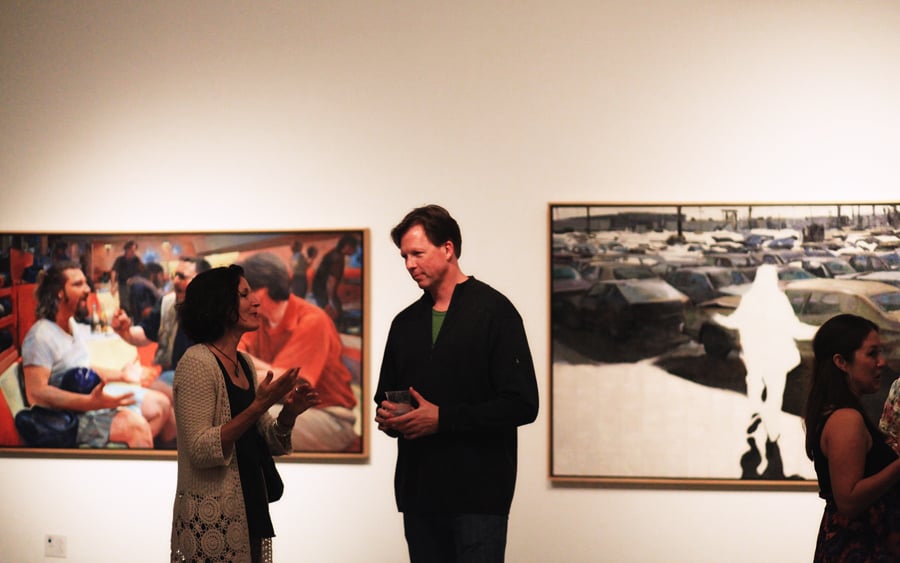
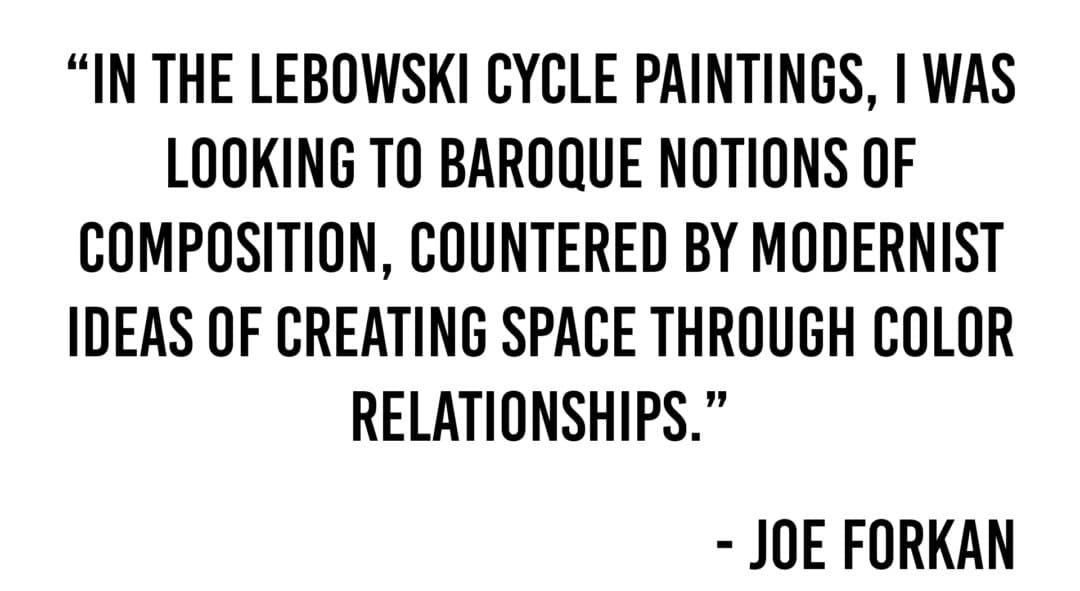
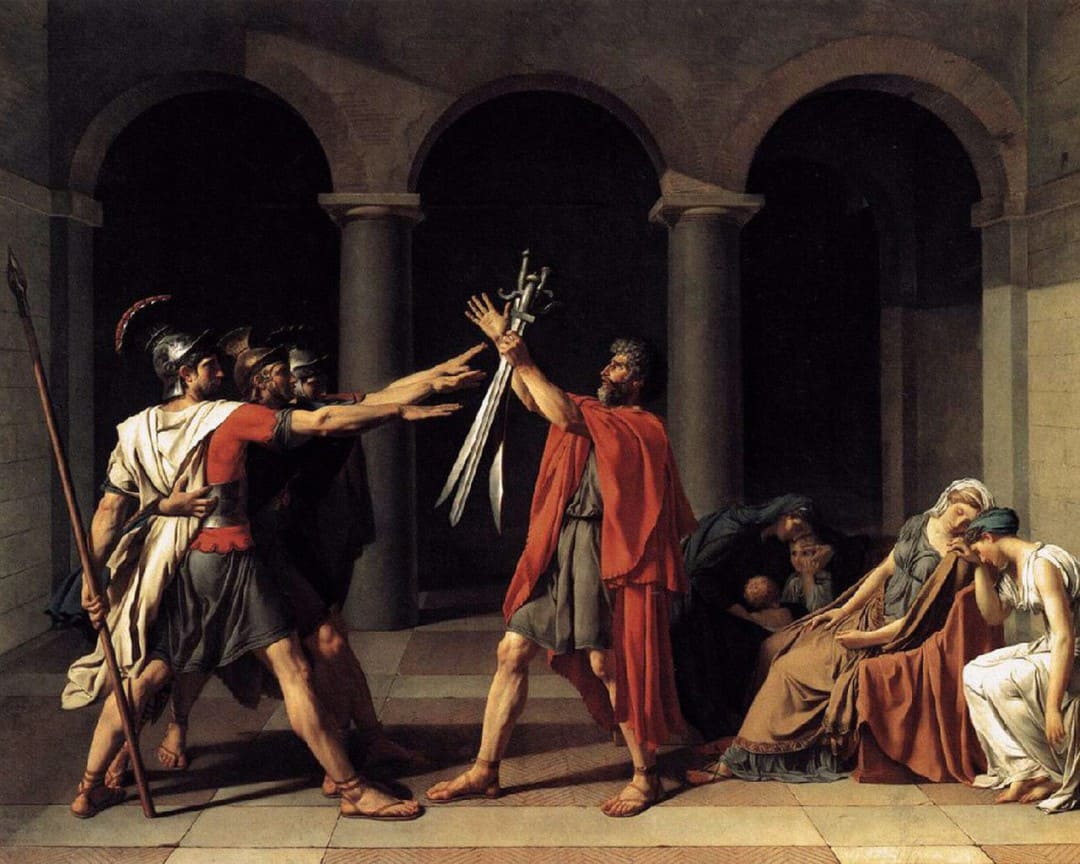
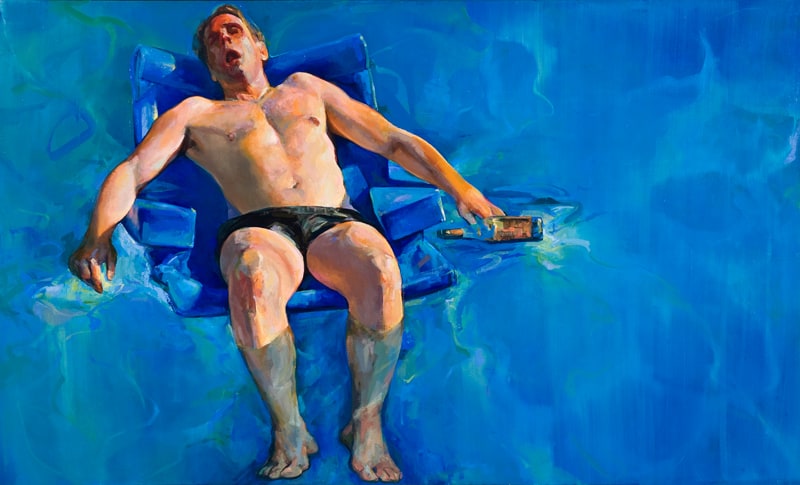
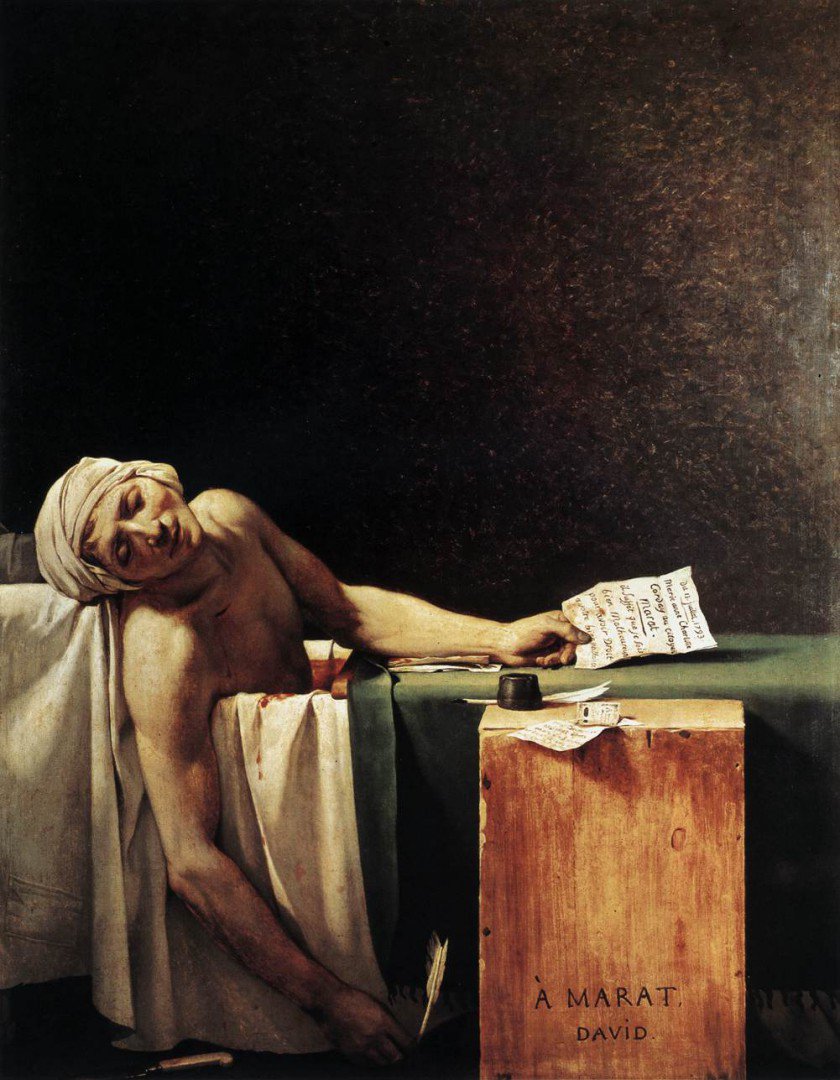
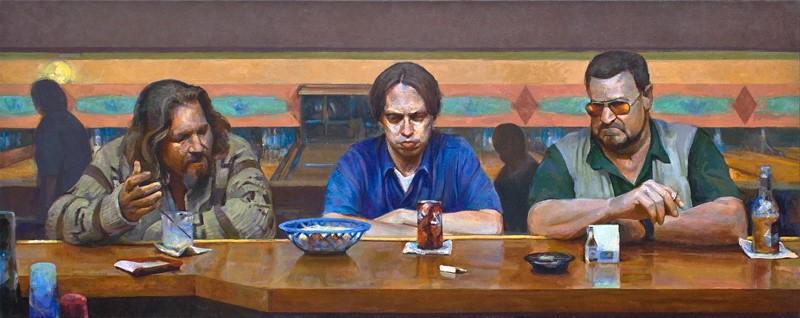
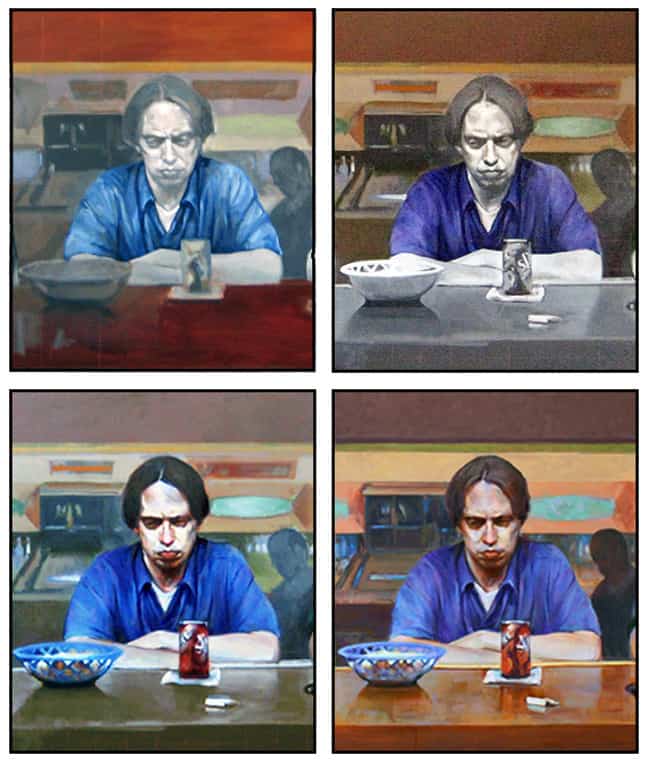
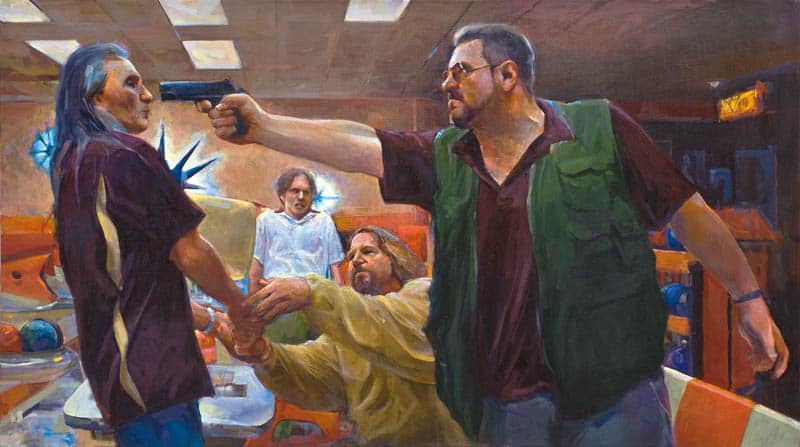
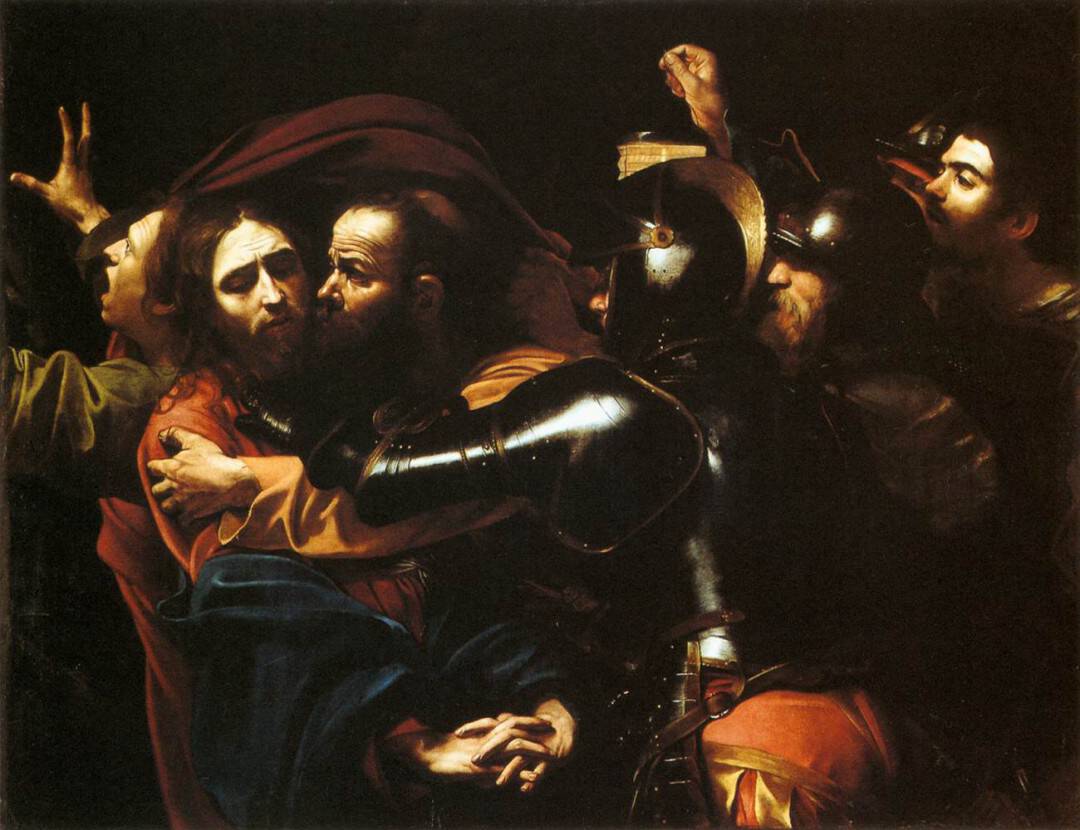
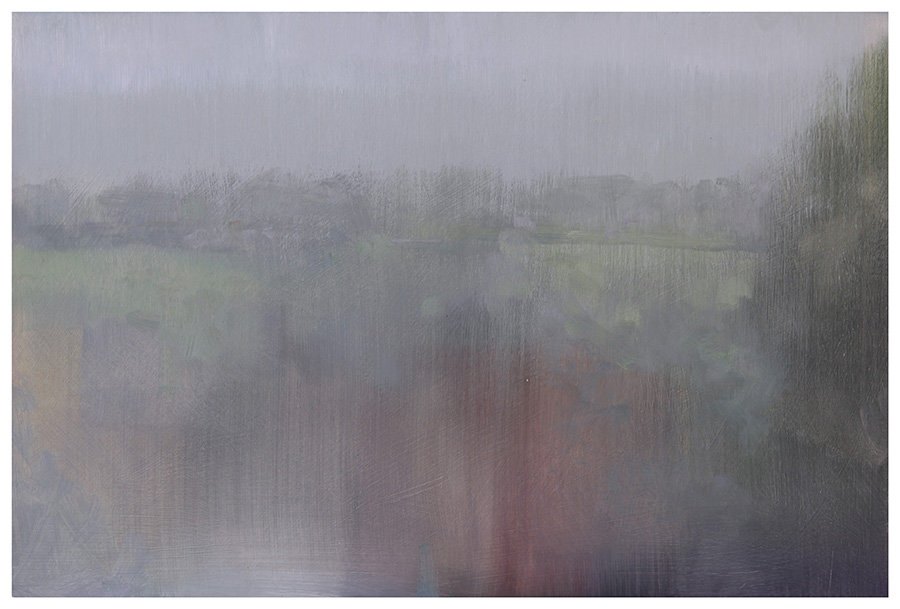
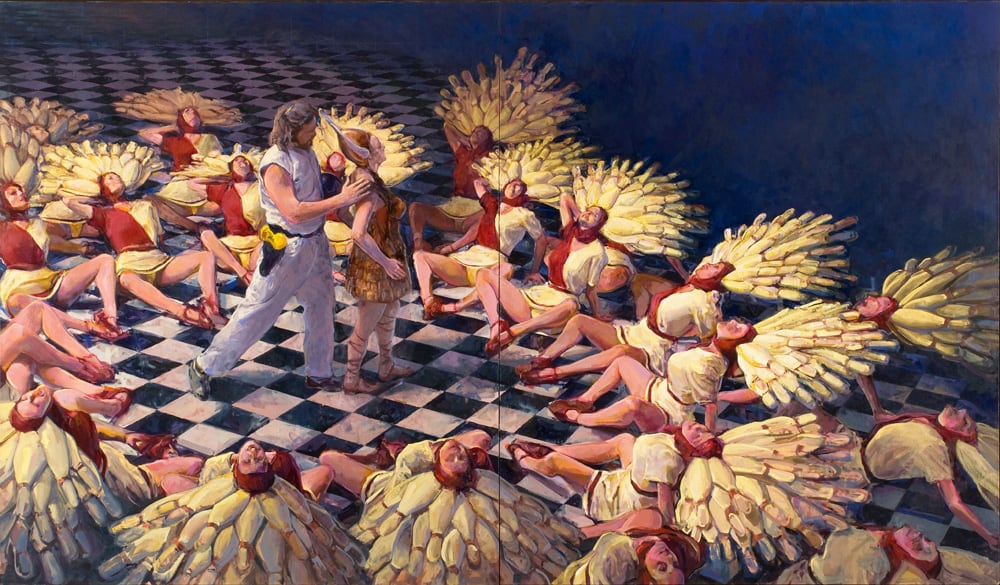

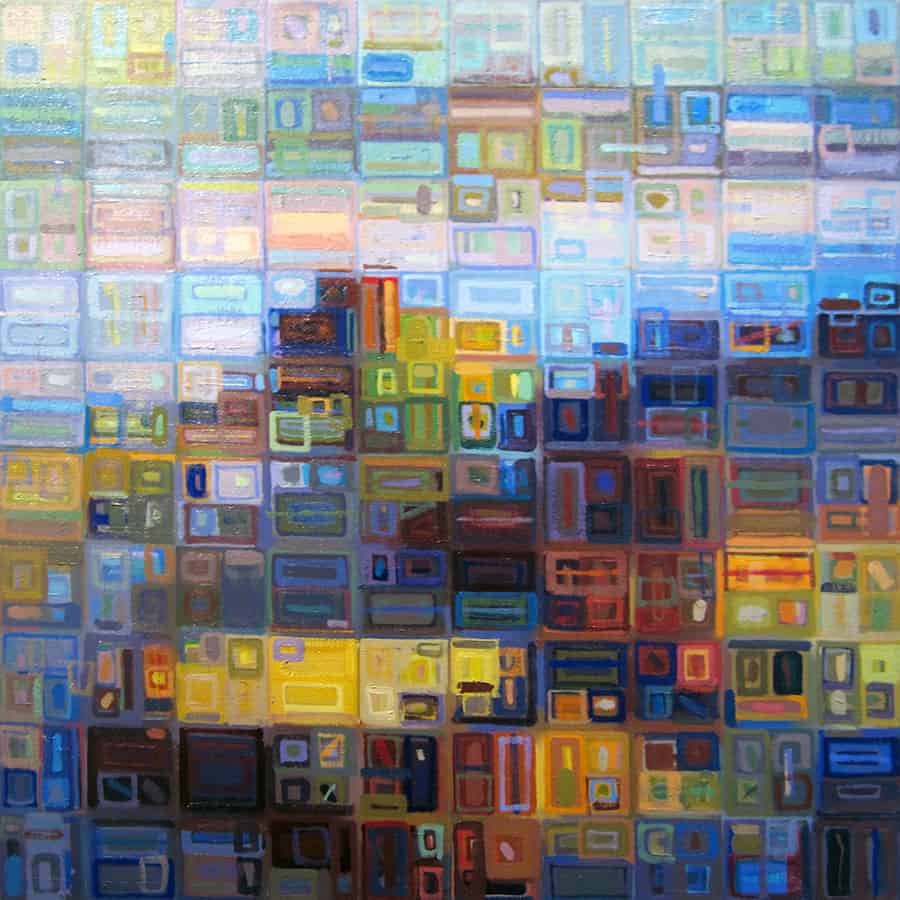
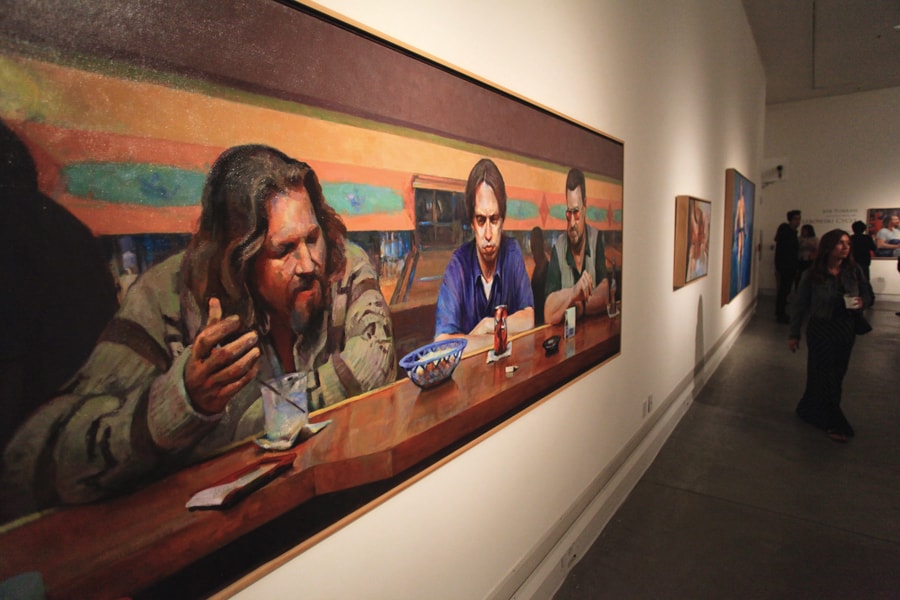
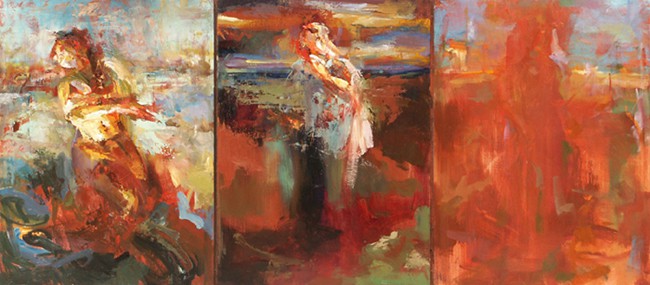
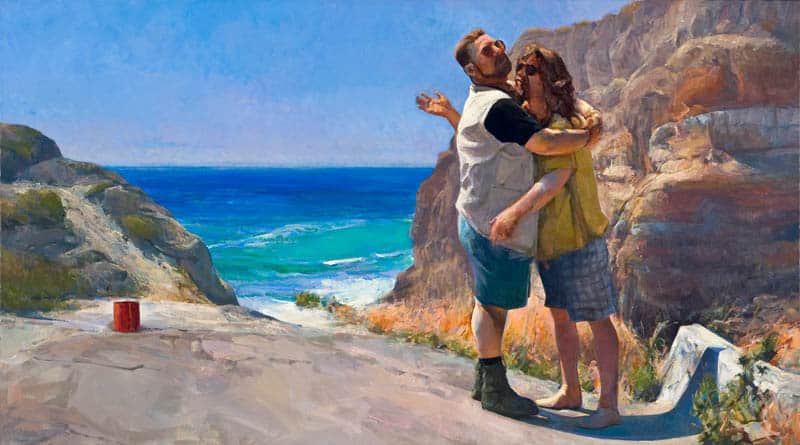
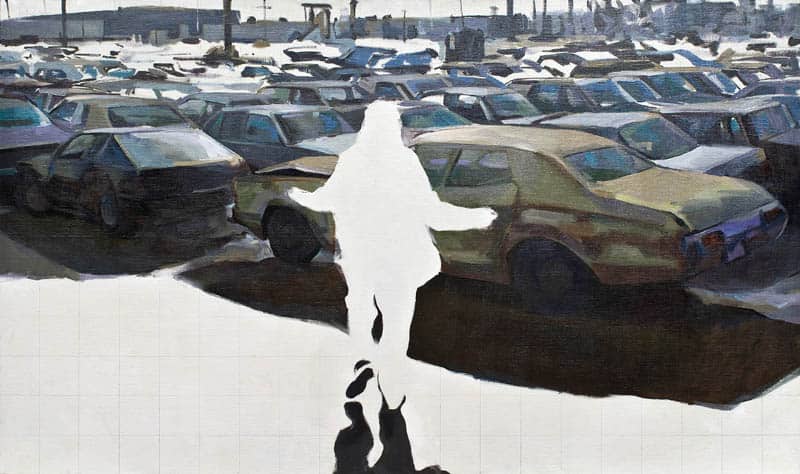
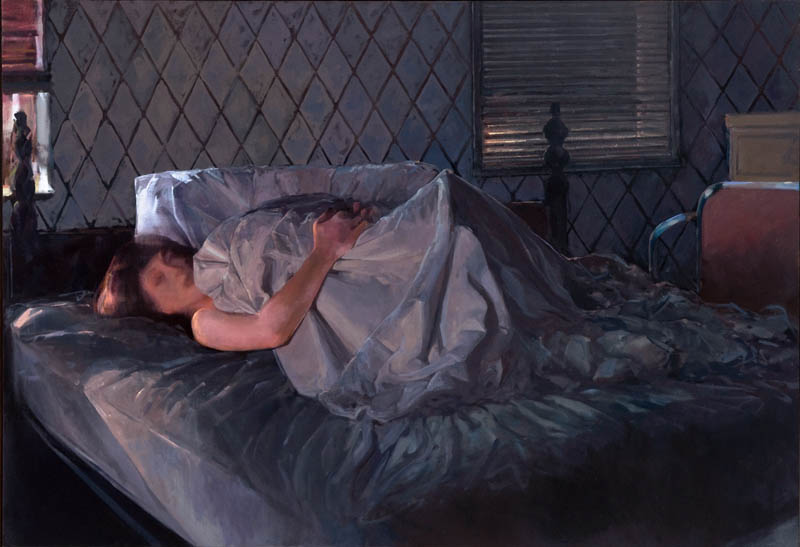
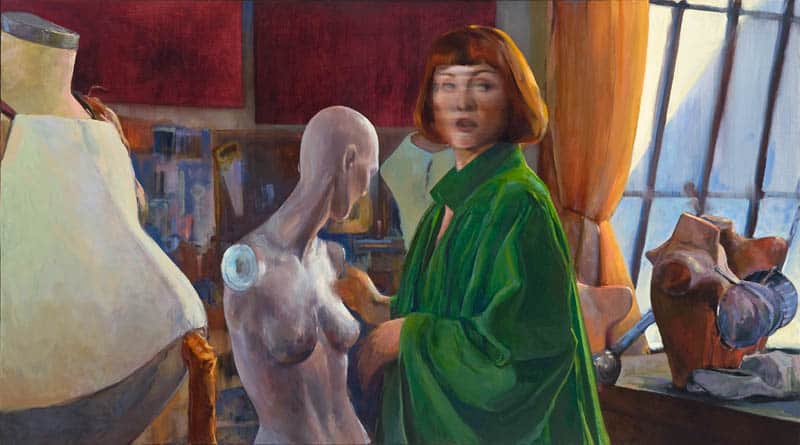
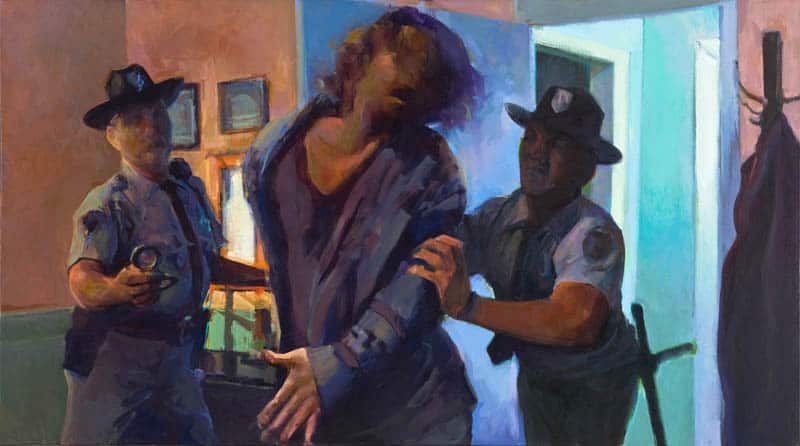
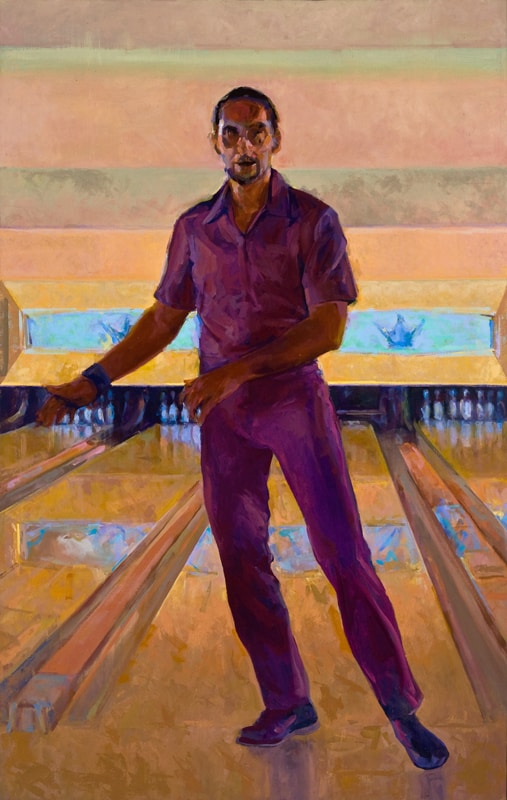
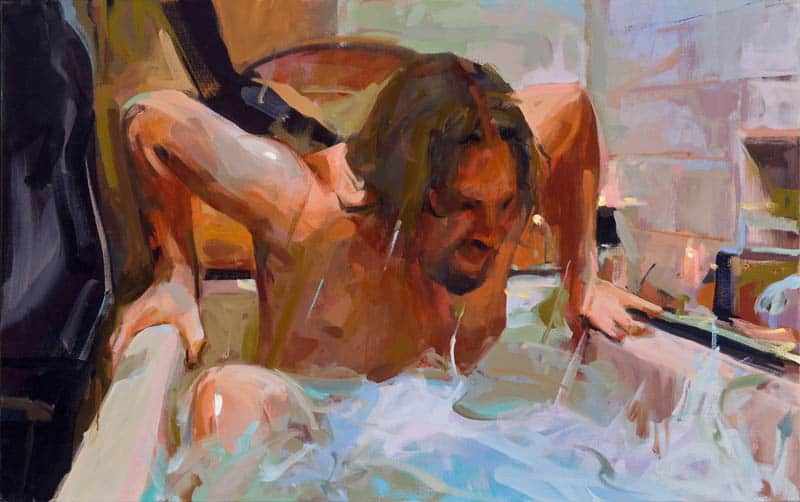
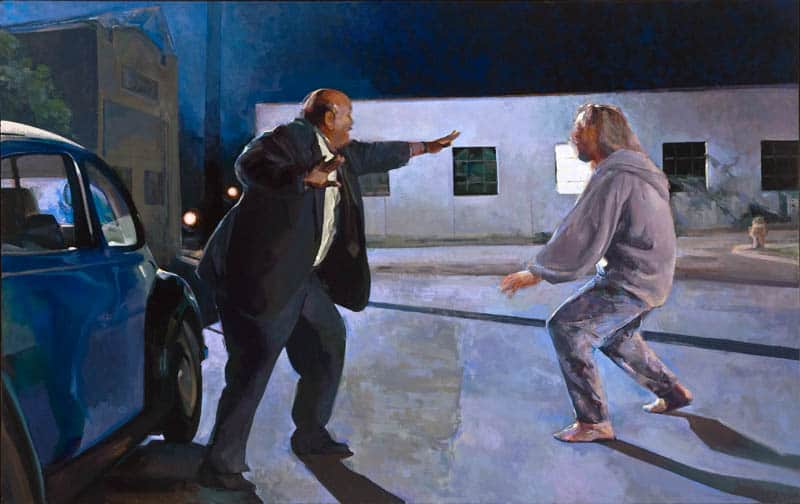
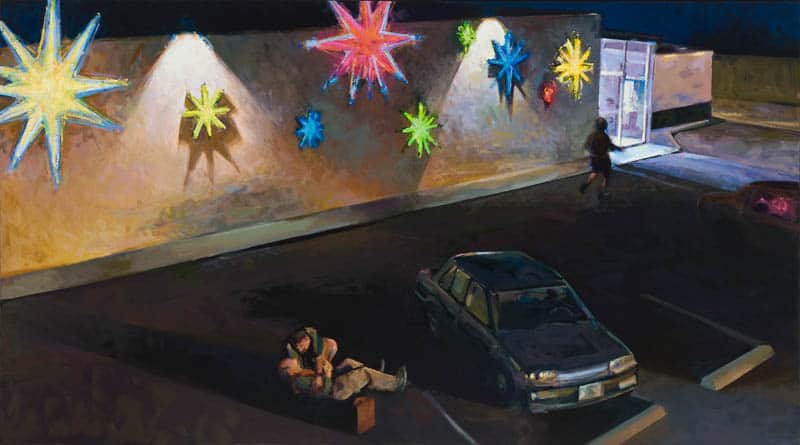
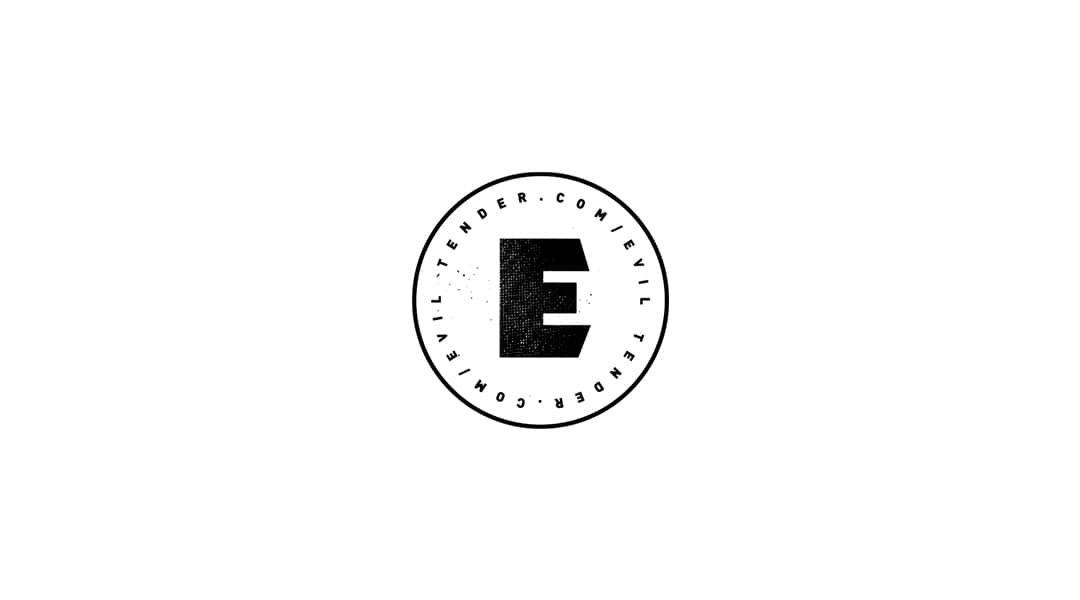
Would love to have one of these on my wall!
I’m hoping he does the full series as prints, then you can have them all!